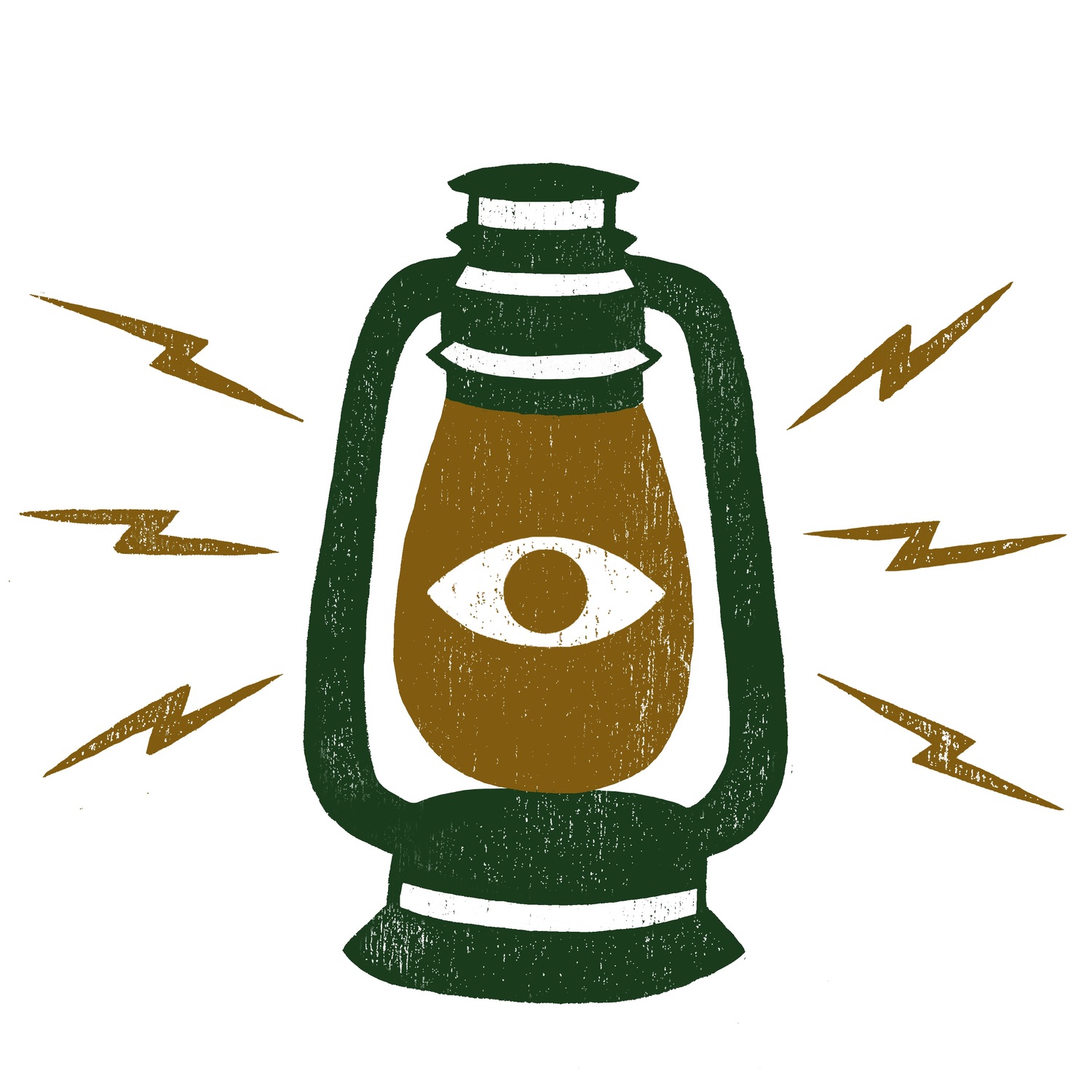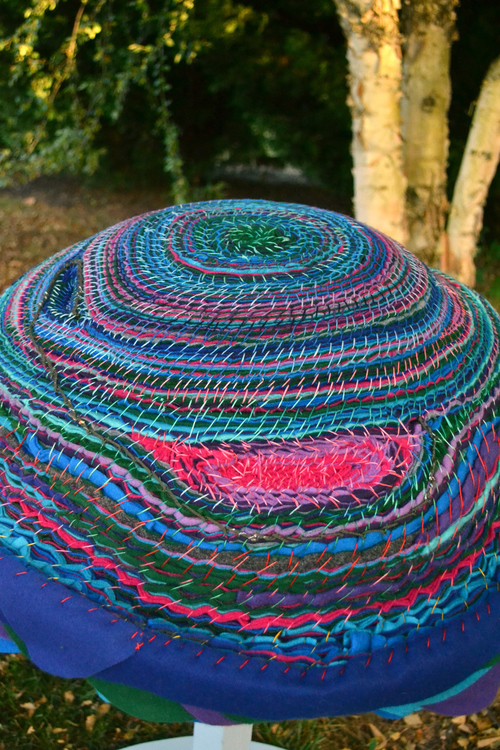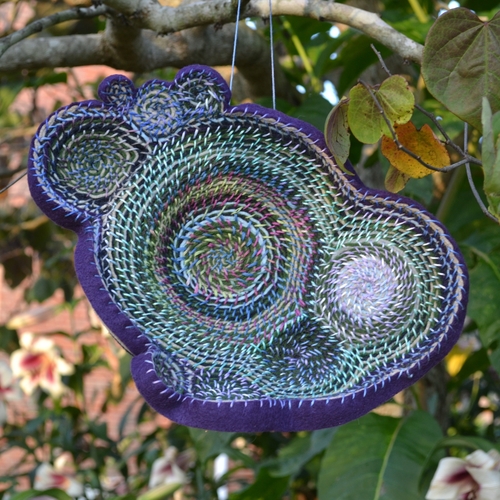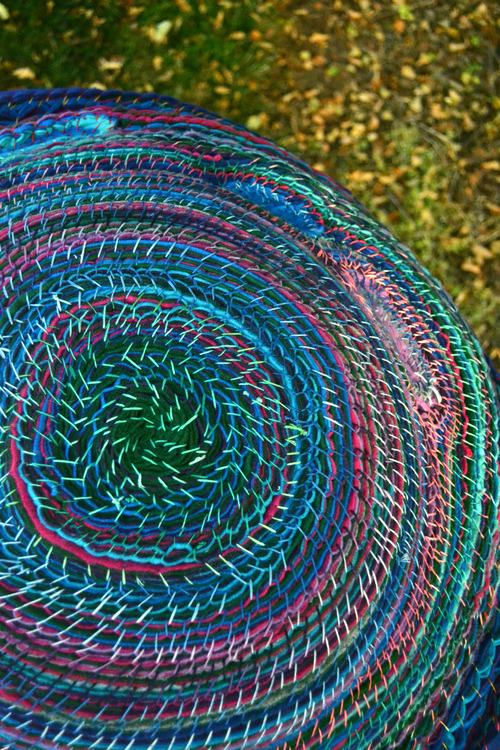Artist Profile: Amy Reader
Amy Reader is a painter, a sculptor, and a fiber & installation artist currently living and working in Charlotte, NC. We had the opportunity to speak with Amy about her work and her life as an artist. To learn about the mind & heart behind Amy's breathtaking pieces, read our conversation below.
Loop (Fiber Sculpture)
Were there particular flowers and natural forms that inspired Loop?
Previously, I’ve worked directly from specific flowers but the series “Loop” is a departure from the literal interpretation. Zinnias, marigolds and white anemones are my favorite subjects; however, in this collection of works I simplified the forms and echoed some of the colors found in those plants. It is not a literal interpretation of a flower, but a representation of the idea.
For those not familiar with fiber sculpture, in Loop, what particular techniques and styles did you employ?
I actually made up the technique as I worked. I hand sewed all of the pieces using embroidery floss and in some places yarn. I layered strips of felt and sewed them together in the round to create the forms. It is difficult to explain, but it starts as a tiny circle of felt and I hand sew in circles until I’m content with the size. I use variegated embroidery floss and yarn and solid colored strips of felt. I’m sure there are technical terms somewhere for what I’ve done to create the forms, but to me I just sew things together in whatever way will yield the look I have in mind while remaining structurally sound. It’s intuitive and flexible as opposed to rigid and formulaic.
How did you know when Loop was “done”?
For each of the pieces in Loop, I declared them “done” when I looked at them and couldn’t think of anything else to add. There isn’t a big moment, sometimes I’m stuck thinking what else does it need and it might be a few days before I realize the reason I’m stuck is because it doesn’t need anything. At that point I just walk away. I take a few pictures and make sure that I’m content and that’s about it.
Zen (Installation)
What inspired your process for Zen?
Zen started out as sort of a fluke in a way. I drink a lot of tea – hot and cold. When I finished steeping a cup I put the used tea bag down on a napkin and forgot about it for a little while. When I came back, I noticed that the tea had stained the napkin in multiple colors and it reminded me of a flower petal, so I kept the napkin. I did the same thing the next day and kept that up for about a week. My roommates were a little confused by the stack of colorful napkins in our kitchen, but they tolerated my quirks. Fast forward a month and I was getting every flavor of tea imaginable and hoarding pretty colored napkins and moved the production into my studio. I didn’t know exactly what I was going to do with these napkins, but I had hundreds of them and eventually filled the entire floor of my studio and started experimenting with ways to attach them and layer the colors. I knew I wanted it to look like it was growing, so I tea stained muslin to match and began attaching it to the muslin with fabric glue. Eventually it took the final form and I remember stepping back and being content with this giant tea creation that resulted from one accidental napkin.
The Life of the Artist
Since you’ve always been an artist, we won’t ask how you got started but do you have any vivid memories of your self-actualization as an artist? Were you working on a masterpiece in kindergarten and looked over to see all the other kids were coloring in My Little Pony coloring-books?
I remember that I always loved to draw but I didn’t consider myself an artist or consider it as a career until late in high school. It wasn’t actually until I started thinking about college majors that I realized I considered myself an artist. Art had always been a part of my life, but I didn’t realize how big of a part it was. It was always something I just did for me until senior year my AP Art teacher pushed the advanced students to enter into some local shows and so of course I did and I won an award in each show. I didn’t win the entire show or anything like that, but it was the first time I had received any sort of “real” recognition or affirmation. In high school I did 100 things: sports, clubs, everything to be a well-rounded student. I knew I would stop doing a lot of those things when I went to college and had to pick a focus. I realized then that art wasn’t optional for me. It wasn’t something that I was doing just because it was fun and I needed a filler class, or to make me a better applicant for college, it was something that was a necessary part of my life. I haven’t looked back since.
Where does your signature palette originate from?
In high school I worked primarily with colored pencils and was immediately drawn to the way the cooler colors looked on the paper. I loved layering the colors and blending them together and they reacted in a way that the warmer colors didn’t. Yellow is a very thin pigment and building up layers with it is much more tedious and doesn’t look the same as cooler tones. Red tends to dominate an area in a way that I didn’t like and I think of red as an aggressive color that steam rolls over its neighbors. Blues, greens and purples can be subtle and they blend well into each other. I don’t have a set amount of each color - I play with my palette and it is always changing; lately there has been a lot more green in my work than previously. But the deep, rich cool tones are what I love. I also strongly dislike the color orange so that’s not one I’m likely to ever use.
What type of art inspires you? Which artists specifically do you look up to?
The artist that I have loved the most for the longest is Georgia O’Keeffe. As a flower lover and a long time painter, I have adored her work since I was little. I love how her pieces are simultaneously delicate and powerful. Another big one for me is Yayoi Kusama. I saw her work in person in Buenos Aires and I nearly cried with excitement somewhere in between spouting out information about her to my peers in rapid Spanglish and literally bouncing up and down. I love the way she creates an environment that engages the viewer and is always changing. Each person who visits her work has a different experience. I could have stayed in Infinity for hours, but the security guard wouldn’t let me. Lee Bontecou is another who holds a special place in my heart. Her wall pieces are stunning and I love the way she creates so much dimension and interest with a limited color palette. The list keeps going including Tara Donavon, Eva Hesse, Anish Kapoor, Yin Xiuen, Emily Barletta and so many more.
You mentioned in a vlog that one of your future aspirations is to work with artists to help them “find what their art is about.” If you had to say - what is your art about?
My art is about my process. The time that I sit and work on a piece is just as important as the final outcome. Since my primary medium is fiber, each stitch is important. I work in the details and each detail serves a purpose and has been carefully thought out.
We noticed on social media you’re yarn bombing Charlotte! Is that part of a larger initiative? How did you get involved?
That is under Charlotte Center City Partners – they received a grant last year to implement public art and community building installations along the Rail Trail and have been commissioning projects from local artists and I am one of those people! I met one of the women who is in charge of distributing the grant and finding projects to implement at a meet up for local creative women hosted by Studio Cultivate. She told me what she was working on, and I remember saying somebody should yarn bomb that (the Rail Trail), we exchanged business cards as did another local fiber artist – Sydney Sogol – and we got an email a little bit later, and now we are #yarnbombingclt!
Is yarn bombing a form of empowerment for you? Or expression?
My thesis project, the #100womenproject, was about empowerment through fiber art. The yarn bombing that I am currently doing in Uptown Charlotte is more about expression and plays off of the movement of the train. Sydney Sogol and I collaborated on the design and the entire piece on the fence echoes the explosive movement of the light rail. When viewed from the Rail Trail, the piece reads from left to right and the pattern breaks and explodes out across the fence.
Because some of your work is inspired by nature, has living in different environments and moving from Virginia to Charlotte affected your art?
I grew up in Chicago, IL where I developed my love of flowers. I spent hours outside drawing in a local botanical garden and I drew flowers every chance I had. Since then I’ve moved a few times – CHI to CLT to RVA and back to CLT and a handful of times within those cities. Whenever people ask me where I am from, I never know how to answer that question. Art has served as my home and provided a sense of stability in that every spring there will be flowers. They always bloom regardless of my geographic location. That’s been my anchor throughout the chaos of life.
You’ve mentioned that in the past few months, you’ve embarked on a journey of discovering your place in the fiber art world. What have you discovered so far? What does the road ahead look like?
So far I have learned the importance of a good thimble – I’ve stabbed my thumb a lot. I’m still trying to figure out a good balance between painting and fiber work. I’ve always been a painter who could hem her own pants – a necessary skill when you’re a shorty like me. Now I’m trying to make sense of where the paintings fit in with the fiber pieces and vice versa. Painting is convenient because they’re more manageable in scale, but in an ideal world I would be working on gigantic fiber pieces 98% of them time. In the future, I am looking to do more site-specific pieces. I prefer working off of something instead creating something independently and then just hanging it on a wall. I want to infiltrate and absorb my work into an environment where the piece and the space surrounding it complement each other. I’m also incorporating multiple types of fiber and fiber techniques into the same piece –sewing, knit, crochet and felt, fabric, embroidery floss and yarn.
ARTIST BIOGRAPHY
Amy received her BA in Studio Art and Comprehensive Education from the University of Richmond, in Virginia. There she was awarded the Capitol One Merit Award for Excellence in Studio Art. Some of Amy’s paintings and sculptures were recently in juried exhibitions in both Tieton,Washington and Matthews, North Carolina. Aside from her own work, Amy interns at Studio Cultivate and works at the Bechtler Museum of Modern Art. You can follow Amy’s day-to-day adventures on Twitter, Instagram and Facebook and visit her artist site.







